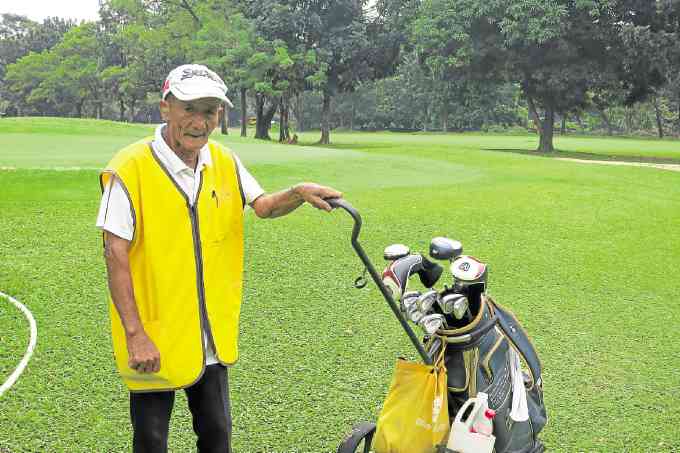The Running Man

Titong, now 70, carries golf bags for a living and calls the caddies’ shack home. —Artemio T. Engracia Jr.
In the pantheon of sports heroes and trail blazers where he rightly belongs, he sticks out like a sore thumb. Withered, frail-looking and toothless, Numeriano Titong hardly cuts the larger-than-life superman figure that we, lesser mortals, imagine our sports heroes to be.
Not quite five feet tall, he is not much taller than the golf bags he carries for a living. In his work place, very few people call him by his first name, simply because they don’t even know that Titong is his family name. At the Veterans Golf Club in Quezon City, most everyone—golfers, club officials and fellow caddies—know him only as the Running Man.
Forty-two years ago, the 28-year-old Numeriano A. Titong won the granddaddy of all marathons in the country, the Milo Marathon, becoming the first champion of what would be the longest-running footrace in the country. Today, the Milo Marathon will be staged for the 40th time in a new venue—Iloilo City. None of the marathon finalists, probably not even the race organizers, are even aware of Titong’s existence.
Titong is used to being called by a wrong name. He was an unheralded caddy when he obliterated the field in the oven-hot streets of Metro Manila in 1974 to win the inaugural Milo Marathon, but the newspapers the next day identified him as Numeriano Atitong, simply because organizers had failed to put a space between his middle initial and his family name on the start list of more than 700 runners.
Milo Marathon founder and race director Jose V. Castro Jr., who would go on to earn the reputation as the father of long-distance running in the country, finally got his name right the next year. Titong was faster by two minutes that year, but he had to settle for fourth place behind future Olympian Victor Idava.
For his win, Titong won a box of Milo products and a trophy almost as tall as he was. The next year, Idava won a trip to the Boston Marathon despite missing the qualifying time. While Idava went on to compete in the 1976 Montreal Olympics to become the second Filipino, after Benjamin Silva-Netto, to run the Olympic marathon, Titong faded into oblivion.
On the eve of the 40th Milo Marathon finals, Sunday Inquirer sought out Titong at the Veterans Golf Club. A diminutive man in a worn-out and oversized golf shirt and a faded cap was sitting on the curb near the clubhouse, obviously waiting for a player to drive in for a round of golf at the short and flat layout carved around the old Veterans Memorial Medical Center.
Do you know where Titong is? he was asked. ‘‘Numeriano?’’ he asked back. It was a surprise that somebody at Veterans knew his first name. But of course; the man turned out to be Rolando Titong, one of Numeriano’s five children, and he looked just like his father. Rolando led us to the caddy shack, where the Running Man sat in one corner he considers his home.
‘‘I clean the caddy house everyday. In exchange, they let me sleep here,’’ Numer, as he was called by golfers back in Capitol Hills Golf and Country Club, said. He could not be interviewed at the clubhouse restaurant because caddies are not allowed there, so we settled for a nearby cafeteria which also doubles as a videoke pub. There, over the din of a pick-up basketball game being played outside and the blare of off-tune drunken singers at the next table, Titong, now 70 years old, recounted his life story and his fling with sporting fame.
In his early 20s, Titong was living with his parents in the squatters’ area near the Iglesia ni Cristo central church in Diliman, Quezon City. He sold pan de sal to students at University of the Philippines. When the bakery’s branch on the campus burned down, he took a job as a caddy at the nearby Capitol golf course. That was when he took up running. He started with the three-and-a-half-kilometer distance from home to Capitol. When he got stronger, he started running both ways for 7 km, then later doubled that to 14 km. And it got longer and longer. Before long, he was running 30 km a day, resting to make a living only when his number at the caddies’ queue was called. He has never stopped running since.
In 1971, he joined and won a 38K race in Marikina. That’s when he realized he could compete in longer distances at a higher level of competition. ‘‘My interest in running increased, and I stopped drinking with friends,’’ he recalled.
He made extra money going to places like Quezon, Batangas and Bulacan to run in fiesta races. Once, long after his Milo Marathon win, he went to race in Bulacan, but Lydia de Vega, then the celebrated queen of sprints, recognized him. She asked him to withdraw, gave him “appearance” fee and reimbursed him for his expenses, Titong recalled with an impish smile.
Titong was a reluctant entry when the Milo Marathon was announced. The date was May 26, 1974. The 28-year-old caddy was one of more than 600 runners who showed up at the starting line at Rizal Park. In the days before Brooks, Nike and Adidas, he wore a pair of Marcelo ladies’ rubber shoes so rundown and worn out they were not even fit for walking. The race started at 1:35 p.m., when the sun was at its hottest. The 42.195 km race was run over Metro Manila’s major thoroughfares, including Roxas Boulevard, Edsa, Taft Avenue, España and Magsaysay Boulevard touching Pasay, Parañaque, Makati, San Juan, Quezon City and Manila.
He started in the middle of the field, moving up slowly and passing one runner after another. At kilometer 35, he breezed past the favored Irving Gallardo to take the lead for good, finishing in three hours, four minutes and 10 seconds. It would take almost 30 minutes before the second placer, Ernesto Ledesma, crossed the Rizal Park finish line. By nightfall, only 18 of the original field had crossed the finish line.
Titong came back the next year but finished fourth despite clocking faster than his winning time. He would race in the Milo Marathon twice more, finishing outside the top 50 in 1976. He last ran the race in 2004, when he was close to 60, finishing far behind the top 100.
By that time, Titong had faded into obscurity. His supply of Milo energy drink having long run out and his four-foot, almost life-size trophy having broken down to pieces, the only thing Titong could show for his short-lived glory is a framed magazine clipping given to him by a golfer who turned out to be a retired officer of the makers of Milo, one of the few who remembered him. The clipping was a page from the commemorative magazine featuring the winners of the first 10 Milo Marathons. The list included such champions as Idava, Justo Tabunda Jr., and the late Jimmy de la Torre. The souvenir magazine was the work of this writer.
A couple of years ago, Milo remembered Titong and decided to give him recognition on the occasion of Milo’s 50th anniversary. He was invited to the Philippine Sportswriters Association awards night and, showing up at the Manila Hotel in a borrowed barong, he was paraded onstage along with the Milo Junior Athletes of the Year awardees.
The next morning, he was back at Veterans Golf Club, sweeping the caddy shack floor to earn his place to sleep and waiting for his number to be called so he could earn enough to live. Weather-beaten, weak with a chronic cough and a giant cyst on his left arm but still running, the Running Man has reclaimed his place in obscurity.
